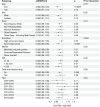Association between the dietary index for gut microbiota and frailty: the mediating role of body mass index
- PMID: 40756558
- PMCID: PMC12313513
- DOI: 10.3389/fnut.2025.1573199
Association between the dietary index for gut microbiota and frailty: the mediating role of body mass index
Abstract
Background: The Dietary Index for Gut Microbiota (DI-GM), a newly introduced metric, indicates gut microbiota diversity. However, its correlation with frailty remains unexplored.
Method: A total of 25,320 individuals were included in the 2007-2020 National Health and Nutrition Examination Survey (NHANES). Dietary recall data were calculated by averaging intake values from two separate 24-h dietary recall interviews. Frailty was assessed using the 49-item frailty index. The relationship between DI-GM and the frailty phenomenon was examined by applying a weighted logistic regression model. A comprehensive sensitivity analysis was undertaken, incorporating restricted cubic splines for modeling non-linear effects, stratified subgroup analyses to explore effect modification, and multiple imputation techniques to address potential missing data concerns.
Results: Higher DI-GM scores and gut microbiota-beneficial dietary components were significantly associated with reduced prevalence of frailty (Frailty Index: OR = 0.987, 95% CI: 0.977-0.997, P = 0.014; Frailty: OR = 0.941, 95% CI: 0.902-0.980, P = 0.004). Restricted cubic spline analysis revealed a non-linear relationship between DI-GM and frailty. Body Mass Index (BMI) mediated this relationship, accounting for 17.57% of the association.
Conclusion: We concluded that a higher DI-GM score is associated with a lower risk of frailty, partly via BMI mediation. Future research should validate these findings using longitudinal studies.
Keywords: NHANES; body mass index; diet; frailty; gut microbiota; mediation.
Copyright © 2025 Lei, Feng, Tian, Zhuang, Zhang, Liu, Yang, Wang, Zhang, Sun and Wang.
Conflict of interest statement
The authors declare that the research was conducted in the absence of any commercial or financial relationships that could be construed as a potential conflict of interest.
Figures




Similar articles
-
Association Between the Dietary Index for Gut Microbiota and Frailty: Mediating Role of Body Mass Index.Food Sci Nutr. 2025 Jul 14;13(7):e70607. doi: 10.1002/fsn3.70607. eCollection 2025 Jul. Food Sci Nutr. 2025. PMID: 40661797 Free PMC article.
-
Dietary index for gut microbiota (DI-GM) and cognitive function: NHANES findings and validation in a Hong Kong cohort with metagenomic data.J Prev Alzheimers Dis. 2025 Aug 4:100319. doi: 10.1016/j.tjpad.2025.100319. Online ahead of print. J Prev Alzheimers Dis. 2025. PMID: 40764207
-
Association between the dietary index for gut microbiota and metabolic syndrome in adults: the mediating role of body mass index.Front Nutr. 2025 Jul 16;12:1598664. doi: 10.3389/fnut.2025.1598664. eCollection 2025. Front Nutr. 2025. PMID: 40740651 Free PMC article.
-
Oral nutritional interventions in frail older people who are malnourished or at risk of malnutrition: a systematic review.Health Technol Assess. 2022 Dec;26(51):1-112. doi: 10.3310/CCQF1608. Health Technol Assess. 2022. PMID: 36541454 Free PMC article.
-
Systemic pharmacological treatments for chronic plaque psoriasis: a network meta-analysis.Cochrane Database Syst Rev. 2021 Apr 19;4(4):CD011535. doi: 10.1002/14651858.CD011535.pub4. Cochrane Database Syst Rev. 2021. Update in: Cochrane Database Syst Rev. 2022 May 23;5:CD011535. doi: 10.1002/14651858.CD011535.pub5. PMID: 33871055 Free PMC article. Updated.
References
-
- Yamaguchi R, Makino K, Katayama O, Yamagiwa D, Shimada H. Relationship between self-rated health, physical frailty, and incidence of disability among Japanese community-dwelling older adults: A longitudinal prospective cohort study. Prev Med. (2024) 191:108210. 10.1016/j.ypmed.2024.108210 - DOI - PubMed
-
- Justina Angel T, Jin Hean K, Reshma Aziz M, Li Feng T. Frailty as a predictor of mortality in the oldest old: A systematic review and meta-analysis. Geriatr Gerontol Int. (2025) 25:102–7. - PubMed
LinkOut - more resources
Full Text Sources

